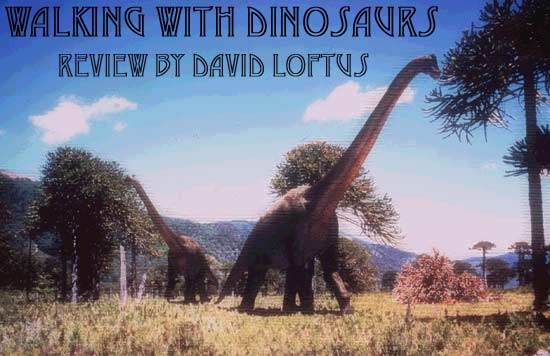|
Part 4: Giant
of the Skies ("Beneath a Giant’s Wings" in the book
version)
Time: 127 million years BCE
Place: "Brazil," the
Atlantic, and "Cantabria" (Spain)
Actual Locations: New Zealand,
Tasmania
Part 4 has the tightest "narrative"
of the six: It follows the single long flight of a mammoth pterosaur
called Ornithocheirus from the southern tip of the Americas and
across the 300 kilometer Atlantic to the breeding grounds in modern-day
Spain.
This flying reptile has a 5-foot
head, and an 11-foot body, but an amazing 40-foot wingspan. (From
below, he looks a little like a Stealth bomber, but with a long,
dull yellow-brown beak with a sort of sighting crest toward its
tip.) On the soundtrack, he gets a chattering woodwind theme that
alternates with a mournful solo violin at appropriate moments.
His voyage provides ample excuse
for panoramic views of seacoasts and the creatures who dwell on
them. It also makes literary sense that, now the series is over
its midway "hump," it approaches the tale in an elegiac
manner: "This is the story of the last journey this giant
ever made."
Guest appearances include the admittedly
"bizarre-looking" Tapejara, smaller pterosaurs with
yellow beaks, blue faces, and an impossibly tall red-orange head
crest; a herd of Iguanodon lumbering good-naturedly along the
beach at the southern tip of North America (to the strains of
a plaintive viola); armored Polecanthus, obviously a forerunner
of the more famous Ankylosaurus, moving with the Iguanodon; closeups
of a wasp at work (flowering plants have just made their appearance
on the planet) and biting parasites at work on the wing membranes
of the pterosaurs; and Utahraptors, very alert-looking 21-foot
runners with vicious sickle claws on each foot. (They are hailed
by bongo drums.)
Another newcomer is announced with
a slight, ominous joke. After arriving in Spain and avoiding some
raptors, "[Ornithocheirus] finds what appears to be an ideal
spot to rest, before this final push to the mating ground. However,
from the dense forest he is being watched by relatives of the
raptors." We don’t see anything but dense, moss-covered tree
trunks for a moment, then get another shot of the vulnerable pterosaur
on the shore, drinking some water.
The "threat" turns out
to be a bird the size of a goldfinch—bright blue with a red and
black markings on wings and tail—called Iberomesornis.
For action shots, Utahraptors make
an unsuccessful attempt on a Polecanthus, then bring down an Iguanodon.
There are some effective animatronic sequences of a raptor bending
down to the camera, looking out of the cave of a carcass, then
picking up bloody entrails and gulping them down in side view.
When our hero reaches the breeding
grounds, however, he is an outcast. More than 40 years old, he
has exhausted his energy from heat stress and lack of food. Spurned
by the females, he lies on the beach to die. A violin playing
high on the fingerboard, timpani and brass rise behind Branagh’s
elegy—"His life has run full circle; in his time he traveled
the globe; but death finds him here…."—for the full lump-in-the-throat
effect, even though this protagonist is the least cuddly-looking
in the series’ lineup. Eventually, a much younger pterosaur is
shown feeding on his dead body.
|

